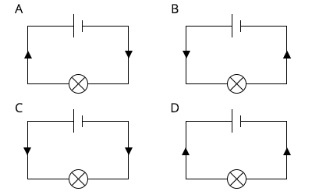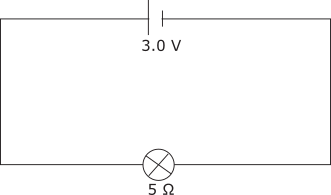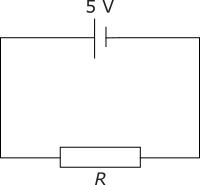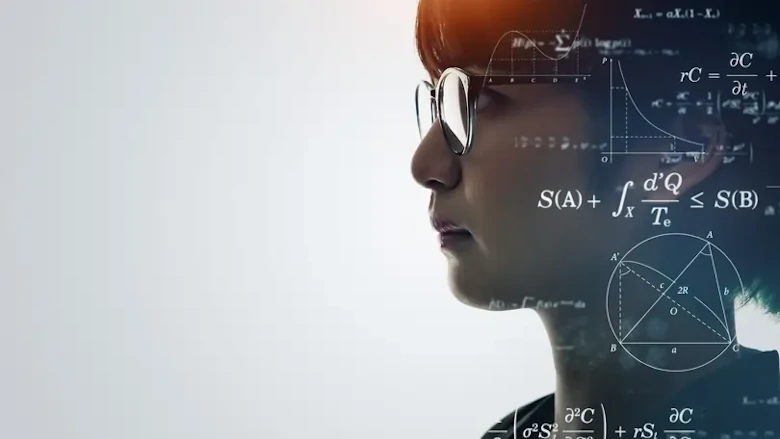Current Electricity
In this article, we will learn about Current Electricity. We will study:
- Electric Current
- Electromotive Force
- Potential Difference
The article is written to meet the syllabus requirements of Secondary 4 Physics grade.
Electric Current
Electrostatics is the study of stationary charges.
Current Electricity involves the study of moving charges.
Components of a Circuit
The labels and the circuit symbols have been mixed up. Can you label them correctly and construct a typical electric circuit with them?
Solution:
These are the four key components in a circuit. The bulb is the load in an electric circuit. It is the purpose for which the circuit is being drawn. The source is the battery to transfer electricity. The metallic wire is the pathway. The switch is for controlling the circuit.
To construct the circuit, we bring together the elements in the following manner.
Conventional Current vs Electron Flow
It has to be understood that the current flow that has been discussed so far is conventional current. However, the actual flow of current, which is basically electron flow, is in the opposite direction.
| Conventional Current | Electron Flow |
|---|---|
| Conventional current is the flow of positive charges (previously thought prior to the discovery of electrons). | Electron flow is the (actual) flow of negative charges (known as electrons). |
| Conventional current flows from the positive to the negative terminals of the battery. | Electrons flow from the positive to the negative terminals of the battery. |
Electric Current
An electric current is a measure of the rate of flow of electric charges through a given cross-section of a conductor. The equation for electric current is therefore:
\(\displaystyle{I=\frac {Q}{t}}\)
Here,
\(I\) is for current.
\(Q\) is for the electric charges.
\(t\) is the rate of flow.
The unit of current is ampere (\(A\)), coulomb (\(C\)) for charge and second (\(s\)) for time.
Question 1:
When a current of 3 A flows for 6 seconds through a lamp, 180 W of power is used. What is the total charge flowing through the lamp?
- 10 C
- 18 C
- 30 C
- 60 C
Solution:
To find the total charge:
\(\begin{align*}\textstyle I&= \frac {Q}{t} \\ Q &= I \times t\\ &= 3 \times 6\\ &= 18\; C \end{align*} \)
So, the correct answer is: B) 18 C
Electromotive Force
Why do the electrons go around the circuit?
There is a driving force, known as the electromotive force (e.m.f.).
What drives the electrons around the circuit?
The dry cell/battery provides the electromotive force that moves the electrons around the circuit.
Fun Fact
Is electromotive force e.m.f. a force?
No. Electromotive force e.m.f. is not a force.
Electromotive Force
The electromotive force e.m.f. of an electrical source is the work done by the source in driving a unit charge around a complete circuit. The formula to calculate e.m.f. is as follows:
In the equation, the units:
\(V\) stands for Volts.
\(J\) stands for Joules.
\(C\) stands for Coulomb.
Question 2:
“The e.m.f. of a dry cell is 2.0 V.”
The above phrase means that
- 2.0 C of charge passes through the cell in 1s.
- The cell applies a force of 2.0 N on each coulomb of charge passing through it.
- The cell supplies 2.0 J of energy to the charge passing through it in 1 s.
- The cell supplies 2.0 J of energy to each coulomb of charge passing through it.
Solution:
(D) The cell supplies 2.0 J of energy to each coulomb of charge passing through it.
Explanation:
This is because e.m.f. indicates joules per coulomb.
Electromotive Force:
When identical cells are arranged in series, the resultant e.m.f. is the sum of all the e.m.f.s of the cells.
When identical cells are arranged in parallel, the resultant e.m.f. is equal to that of a single cell.
Question 3:
Four batteries, each of 2.0 V, are connected as shown.
Calculate the overall e.m.f. registered by the voltmeter.
- 0.5 V
- 1.0 V
- 2.0 V
- 8.0 V
Solution:
C) 2.0 V
Explanation:
The identical batteries are all in parallel configuration. Therefore, the e.m.f in a parallel battery configuration will be the same as that of a single battery.
Thus, the correct answer is: C) 2.0 V
Question 4:
Four batteries, each of 2.0 V, are connected as shown.
Calculate the overall e.m.f. registered by the voltmeter.
- 1.0 V
- 2.0 V
- 4.0 V
- 8.0 V
Solution:
B) 2.0 V
Explanation:
There are two parallel series in the circuit. Hence, upon adding the two parallel series, the e.m.f. will be 2.0 V.
So, the correct answer is: B) 2.0 V
Potential Difference
The potential difference, p.d., across a circuit component is the work done to drive a unit charge through the component.
The equation governing potential difference is as follows:
\(\displaystyle{V(V)=\frac {W(J)}{Q(C)}}\)
Where,
\(V\) stands for Potential Difference.
\(W\) stands for Work Done.
\(Q\) stands for Total Charge.
In the equation, the units are:
\(V\) stands for Volts.
\(J\) stands for Joules.
\(C\) stands for Coulomb.
Electromotive Force (e.m.f.) vs Potential Difference (p.d.)
| Electromotive Force (e.m.f.) | Potential Difference (p.d.) |
|---|---|
| Associated with an electrical energy source (example: a dry cell). | Associated with 2 points in an electrical circuit (example: between a lamp). |
| It is work done by the source in driving a unit charge around a circuit. | It is work done in driving a unit charge across 2 points in the circuit. |
| It is the conversion from chemical energy to electrical energy to drive a unit charge. | It is the conversion from electrical energy to other forms of energy when driving a unit charge. |
Conclusion
In this article, we learned the following details about electric current:
- How to define current and state its S.I. units.
- How to differentiate between conventional current and electron flow.
- Apply formula (charge = current x time) to solve problems.
- Draw electric circuit diagrams.
We also learnt about the electromotive force (e.m.f.) and the potential difference (p.d.) and their S.I. units. We also studied how to calculate the e.m.f. when a few power sources are in series and/or parallel arrangements.
The details covered in the article are as per the Physics syllabus defined for the Secondary 4 grade.
| Continue Learning | |
|---|---|
| Electromagnetic Spectrum | Sound |
| Static Electricity | D.C. Circuits |
| Electromagnetic Induction | Electromagnetism |
| Magnetism | Current Electricity |
| Practical Electricity | |
Test Yourself
Which of the following shows the direction of flow of conventional current?

Conventional current flows from the positive end to the negative end of the cell.
When a current of 3A flows for 6 seconds through a lamp, 180W of power is used. How much charge flows through the lamp?
By Q=It,
Charge = 3 × 6 = 18 C
Ans: (B) 18 C
The circuit below shows an e.m.f. of 3.0V connected to a lamp of 5Ω resistance.

Which of the statements below correctly describes 'e.m.f. of 3.0V'?
A: 6J of work is done by a source in driving a unit charge around a complete circuit.
B: 3J of work is done by a source in driving a unit charge through the component.
C: 6J of work is done by a source in driving 2C of charge through the component.
D: 6J of work is done by a source in driving 2C of charge around a complete circuit.
By ε = W/Q , e.m.f. is defined as the work done by the source in driving a unit charge around a complete circuit,
(B) and (C) are incorrect by definition.
(A) is incorrect because question asks for 3.0V.
Ans: (D) 6J of work is done by a source in driving 2C of charge around a complete circuit.
A simple circuit is set up as shown below.

What is the work done by the 5V cell in moving 10C charge across the resistor?
By E = QV,
E = 10 × 5 = 50 J
Ans: (A) 50 J
Which of the following statement(s) is/are correct?
I: The resistivity of a wire is directly proportional to the cross-sectional area of the wire.
II: The resistivity of a wire is inversely proportional to the length of the wire.
III: The resistivity of a wire is directly proportional to the length and cross-sectional area of the wire.
IV: The resistivity of a wire is independent of the dimensions of a wire.
Choose the correct option
The resistivity of a wire is independent of the dimensions of a conductor. It is an inherent property of the material.
Ans: (C) IV only.




 SG
SG  VN
VN 















